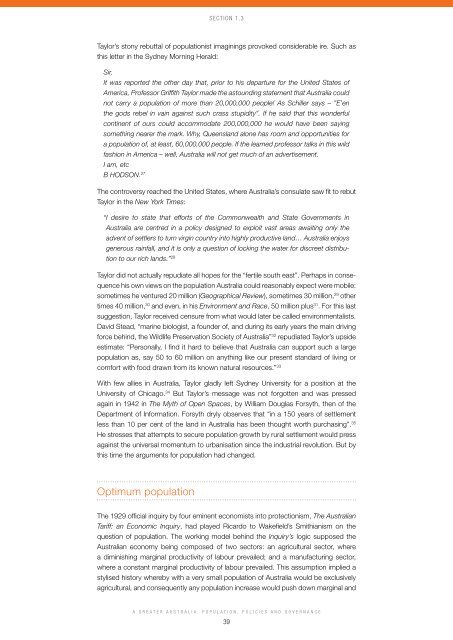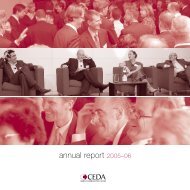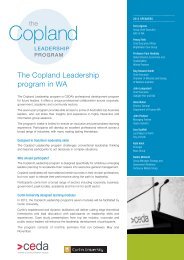A Greater Australia: Population, policies and governance - CEDA
A Greater Australia: Population, policies and governance - CEDA
A Greater Australia: Population, policies and governance - CEDA
- No tags were found...
Create successful ePaper yourself
Turn your PDF publications into a flip-book with our unique Google optimized e-Paper software.
Section 1.3Taylor’s stony rebuttal of populationist imaginings provoked considerable ire. Such asthis letter in the Sydney Morning Herald:Sir,It was reported the other day that, prior to his departure for the United States ofAmerica, Professor Griffith Taylor made the astounding statement that <strong>Australia</strong> couldnot carry a population of more than 20,000,000 people! As Schiller says – ”E’enthe gods rebel in vain against such crass stupidity”. If he said that this wonderfulcontinent of ours could accommodate 200,000,000 he would have been sayingsomething nearer the mark. Why, Queensl<strong>and</strong> alone has room <strong>and</strong> opportunities fora population of, at least, 60,000,000 people. If the learned professor talks in this wildfashion in America – well, <strong>Australia</strong> will not get much of an advertisement.I am, etcB HODSON. 27The controversy reached the United States, where <strong>Australia</strong>’s consulate saw fit to rebutTaylor in the New York Times:“I desire to state that efforts of the Commonwealth <strong>and</strong> State Governments in<strong>Australia</strong> are centred in a policy designed to exploit vast areas awaiting only theadvent of settlers to turn virgin country into highly productive l<strong>and</strong>… <strong>Australia</strong> enjoysgenerous rainfall, <strong>and</strong> it is only a question of locking the water for discreet distributionto our rich l<strong>and</strong>s.” 28Taylor did not actually repudiate all hopes for the “fertile south east”. Perhaps in consequencehis own views on the population <strong>Australia</strong> could reasonably expect were mobile:sometimes he ventured 20 million (Geographical Review), sometimes 30 million, 29 othertimes 40 million, 30 <strong>and</strong> even, in his Environment <strong>and</strong> Race, 50 million plus 31 . For this lastsuggestion, Taylor received censure from what would later be called environmentalists.David Stead, “marine biologist, a founder of, <strong>and</strong> during its early years the main drivingforce behind, the Wildlife Preservation Society of <strong>Australia</strong>” 32 repudiated Taylor’s upsideestimate: “Personally, I find it hard to believe that <strong>Australia</strong> can support such a largepopulation as, say 50 to 60 million on anything like our present st<strong>and</strong>ard of living orcomfort with food drawn from its known natural resources.” 33With few allies in <strong>Australia</strong>, Taylor gladly left Sydney University for a position at theUniversity of Chicago. 34 But Taylor’s message was not forgotten <strong>and</strong> was pressedagain in 1942 in The Myth of Open Spaces, by William Douglas Forsyth, then of theDepartment of Information. Forsyth dryly observes that “in a 150 years of settlementless than 10 per cent of the l<strong>and</strong> in <strong>Australia</strong> has been thought worth purchasing”. 35He stresses that attempts to secure population growth by rural settlement would pressagainst the universal momentum to urbanisation since the industrial revolution. But bythis time the arguments for population had changed.Optimum populationThe 1929 official inquiry by four eminent economists into protectionism, The <strong>Australia</strong>nTariff: an Economic Inquiry, had played Ricardo to Wakefield’s Smithianism on thequestion of population. The working model behind the Inquiry’s logic supposed the<strong>Australia</strong>n economy being composed of two sectors: an agricultural sector, wherea diminishing marginal productivity of labour prevailed; <strong>and</strong> a manufacturing sector,where a constant marginal productivity of labour prevailed. This assumption implied astylised history whereby with a very small population of <strong>Australia</strong> would be exclusivelyagricultural, <strong>and</strong> consequently any population increase would push down marginal <strong>and</strong>A <strong>Greater</strong> <strong>Australia</strong>: <strong>Population</strong>, Policies <strong>and</strong> Governance39





